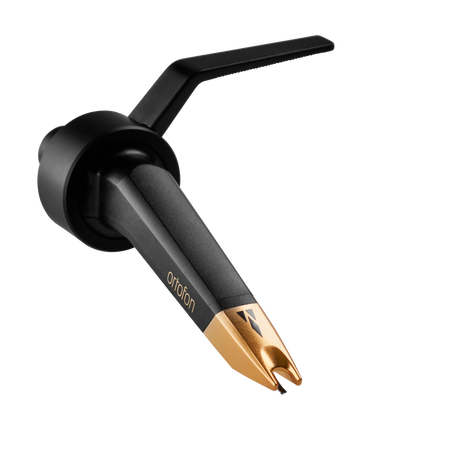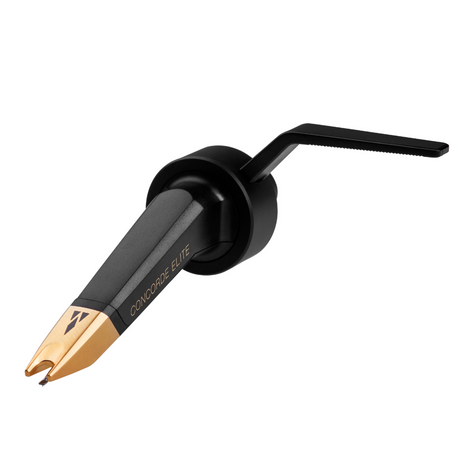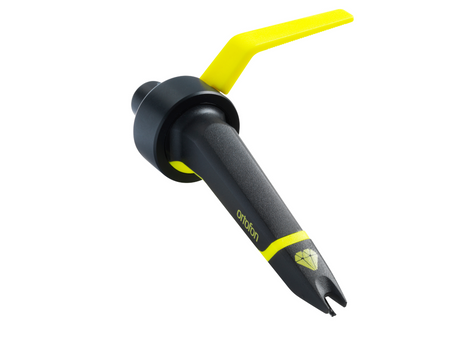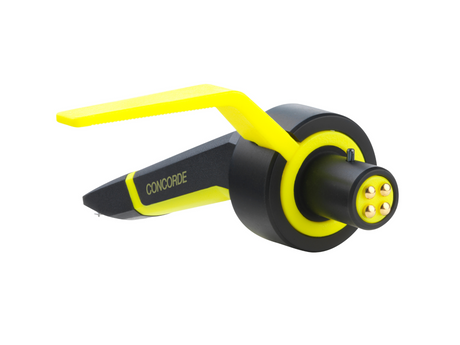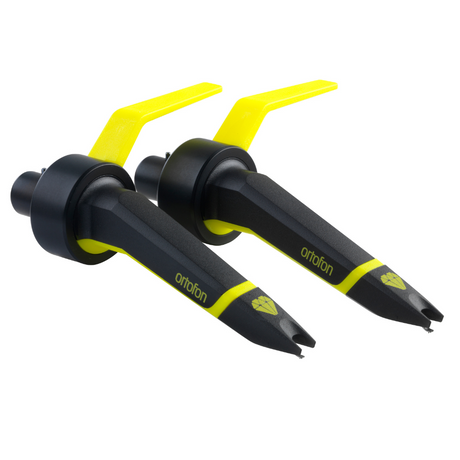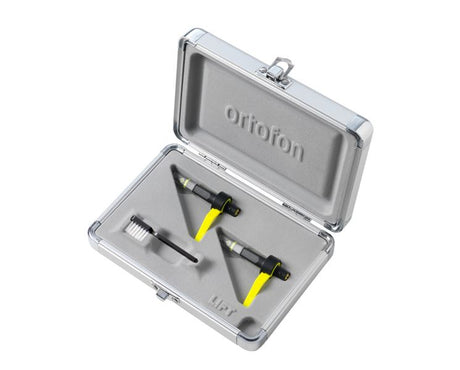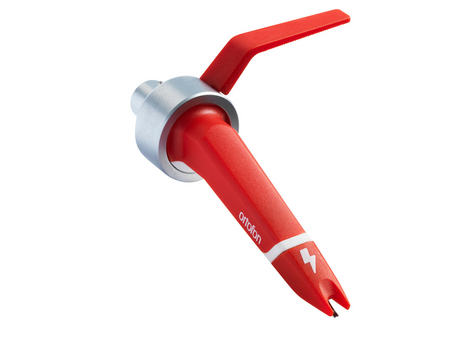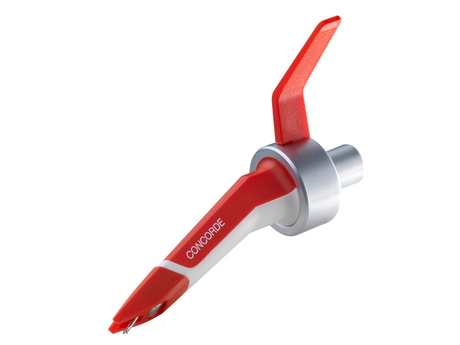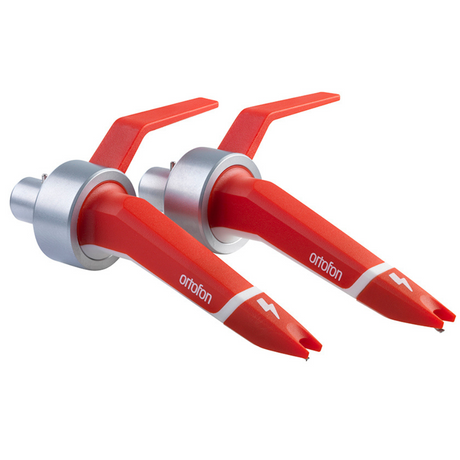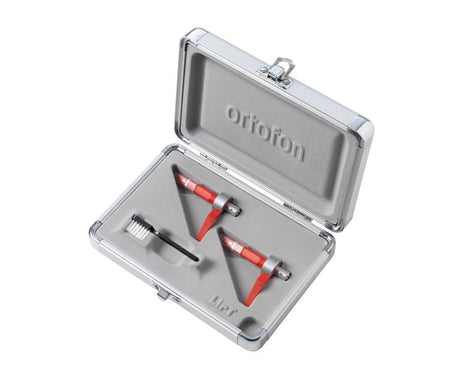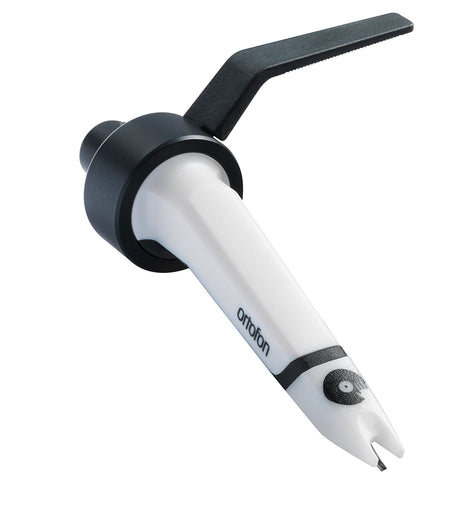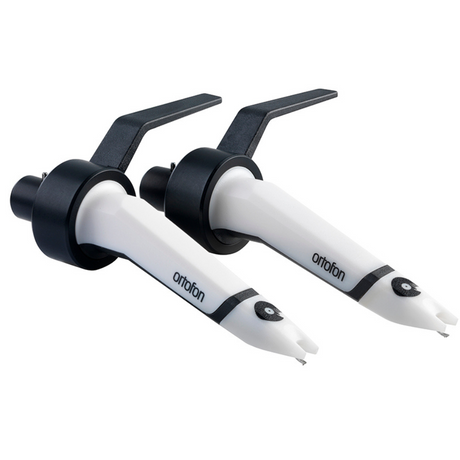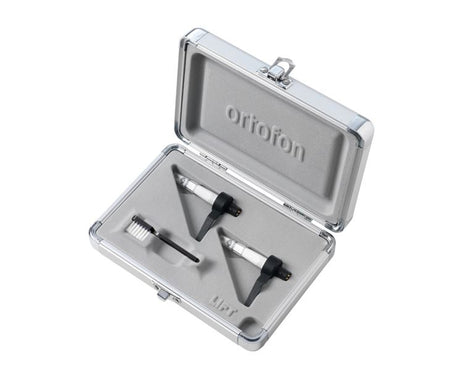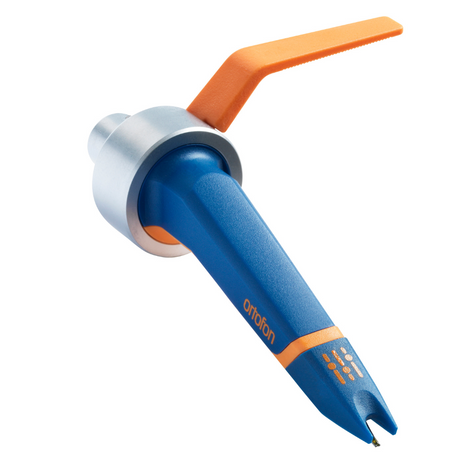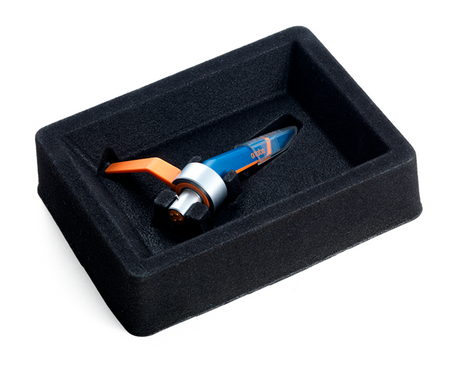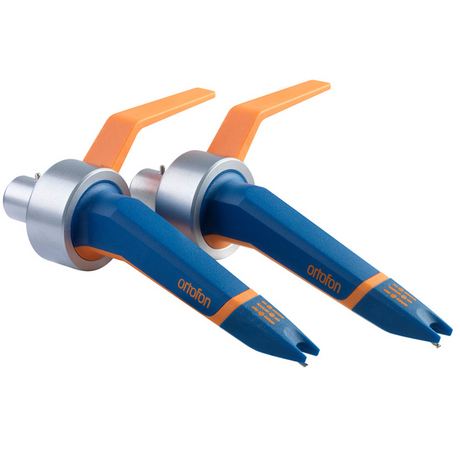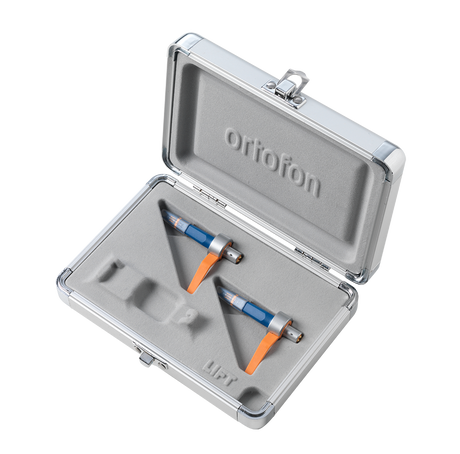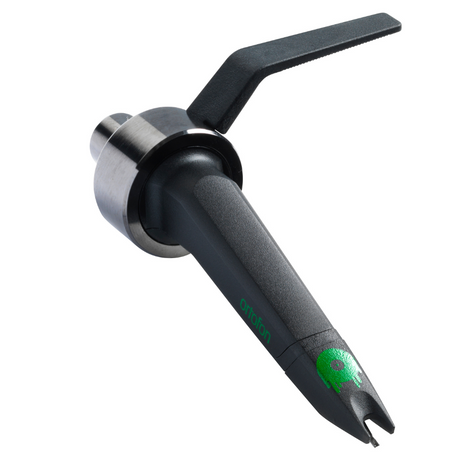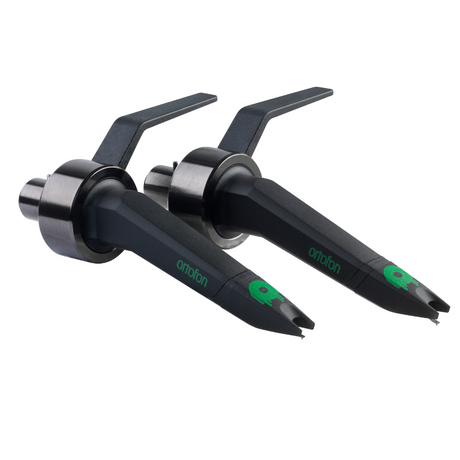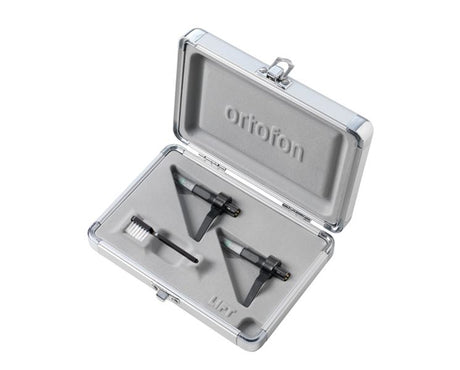FAQs
Can Concorde cartridge be used on straight-arm turntable?
Can Concorde cartridge be used on straight-arm turntable?
First of all, straight arm DJ turntables are designed strictly for sheer groove-holding capability, and not for fidelity. Harmonic distortion on a short, straight tonearm will increase by double, which can limit the effectiveness of any great sounding cartridge, regardless of manufacturer.
Using a Concorde cartridge will work fine, granted that is a spherical stylus. It should be noted that an elliptical stylus will likely not sit properly within the groove, and may result in unbalanced sound reproduction on this type of tonearm.
Can I angle my cartridge to crudely emulate a straight tonearm?
Can I angle my cartridge to crudely emulate a straight tonearm?
The practice of angling the cartridge 23 degrees counterclockwise directly against the tonearm pivot is a practice that is sometimes performed to increase tracking. However, this will cause excessive wear to your vinyl and also your stylus. This will also result in diminished sound quality, and is not recommended.
How do I set up my turntable?
How do I set up my turntable?
Our step-by-step tutorials will guide you through assembling and configuring your DJ gear like a pro. Whether you're using controllers or decks, we'll help you get the perfect setup to launch your mixing journey.
How to set tracking force to provide best performance?
How to set tracking force to provide best performance?
DJs that use Technics 1200/1210 turntables may need to remove the small cylindrical sub-weight from the rear of the tonearm in order to achieve high enough tracking forces. This sub-weight is located directly on the rear of the tonearm, behind where the counterweight attaches.
- With the weight installed, Concorde cartridges will only be able to achieve 2 grams of tracking force.
- With this weight removed, Concorde cartridges will be able to achieve approximately 4.75 grams of tracking force.
Additional weight can be applied by turning the counterweight backwards so that the number scale faces the rear of the turntable.
When using OM style cartridges, the weight of the headshell being used will tend to dictate how much weight can be applied. It may be necessary to use the weight plate included with the OM cartridge, which should be sandwiched between the top of the cartridge and the headshell during mounting.
How exactly do I set the tracking weight adjustment?
How exactly do I set the tracking weight adjustment?
On the rear of the tonearm is a counterweight which consists of two parts – the adjustment dial and the weight itself.
- First, remove the plastic stylus guard from the cartridge.
- Next, turn the weight in the appropriate direction so that the cartridge floats directly above the platter – it should not make contact with the platter, nor should it point up in the air.
- When you have achieved this point, immediately lock the tonearm in its rest, and then move only the adjustment dial (not the weight itself) to ‘0’.
- Finally, turn the entire assembly (both the dial and the weight itself) until you achieve the desired weight.
Take care not to deviate outside of the Tracking Force Range as specified by the included documentation, as it may result in skipping, poor sound quality, or unnecessary wear on your vinyl.
DJ Rafik explains how to adjust the weight on your turntable,
view the Tutorial
Which cartridge is best for my style of music?
Which cartridge is best for my style of music?
Choosing the right cartridge for your style of music is essential to achieve the best audio performance. Here are our recommendations based on different music styles:
Basic: If you're looking for a versatile cartridge suitable for various music genres, we recommend the MIX or OM Pro S cartridge.
DJ: If you're a DJ and need a reliable cartridge for mixing and blending tracks, the DJ cartridge is an excellent choice.
Club: For those who enjoy the vibrant atmosphere of clubs and want a cartridge that can handle heavy use, the CLUB cartridge is designed to meet your needs.
Scratch: If you're into scratching and turntablism, the SCRATCH or OM Q.Bert cartridges are specifically engineered for precision and durability during scratch sessions.
Specialized: If your music style is more digital or electronic, the DIGITAL cartridge is designed to provide optimal performance in the digital realm.
Remember that your choice of cartridge can significantly impact your audio experience, so it's essential to consider your specific music style and preferences when making a selection. If you have further questions or need additional guidance, please don't hesitate to contact our customer support team for personalized recommendations.
What are the main components of the cartridge?
What are the main components of the cartridge?
A cartridge consists of three basic components: the stylus that traces the record groove, the cantilever, the part on which the stylus is mounted, and the generating system. The generating system converts the motion of stylus and the cantilever into electrical replicas of the sound, which can then be amplified and reproduced by the music system.
1. The stylus
The stylus is the only part of the cartridge to make contact with the record. A force must be exerted by the tonearm to keep the stylus in the groove while the record is spinning. This tracking force is low, usually between three and four grams. But because the stylus has a “footprint” of less than one millionth of a square inch of the record face, it exerts a tremendous pressure: 6,000 pounds per square inch. At such enormous pressure, any roughness or irregularity in the stylus would cause record damage. The stylus must also be very hard or it will wear out quickly. For these reasons, quality styli are precision made from the finest and hardest material known: pure diamond. Spherical stylus is for heavy back-cueing and scratching. Stays in the groove. Elliptical stylus is for lighter back-cueing and scratching. Best sound performance.
2. The cantilever
The purpose of the cantilever is to act as an intermediate between the stylus and the generating system. Compared to its size the stylus moves at tremendous speed while tracking the groove of the spinning record. In order that the cantilever may accurately transmit the rapid stylus movements, it should be lightweight so it can respond without inertia to the twists and turns of the groove. At the same time the cantilever should be rigid, because any bending, flexing or vibration would add distortion and sound coloration. The necessary compromise between lightweight and high strength requires great ingenuity in the design as well as the choice of the materials.
3. The generating system
High fidelity Ortofon cartridges follow the law of electromagnetism, discovered by the Danish scientist H.C.Oersted. When material capable of conducting electricity (a copper coil) is set into motion perpendicular to a magnetic field - or when a magnet is moved near such conductive material – electrical current is generated in the circuit. The direction and speed of the movement determine the amplitude and frequency of the current. Thus the generating system of a cartridge converts the movement of the stylus and cantilever into an output signal.
What are the mounting dimensions of my cartridge?
What are the mounting dimensions of my cartridge?
Concorde Series
Effective length: 51.5 mm
Height: 14 mm
VNL Series
The height from stylus tip to top cartridge mounting surface: 18 mm
Distance from stylus tip to the centre of mounting holes: 8.2 mm
Cartridge length without connector pins: 24.1 mm
Cartridge length including connector pins: 27.3 mm
Distance between centres of mounting holes: 12.7 mm
Cartridge width: 16 mm
Mounting holes diameter: 2.8 mm
Are Ortofon's cartridges' styli interchangeable?
Are Ortofon's cartridges' styli interchangeable?
Concorde MkI and Concorde MkII styli are not interchangeable and will not even fit physically.
Physically, each series of stylus will fit on alternate cartridge bodies. However, these combinations are not supported by Ortofon, as each cartridge series is designed with a synergistic combination in mind - that is, each stylus is made to compliment the magnet and coil configuration of each cartridge body.
For instance, using a MIX stylus with a SCRATCH body will not provide the full benefit of either product, and might even provide undesired results, including (but not limited to) differences in output, unbalanced sound reproduction, etc.
NB: In the case of the discontinued NightClub and DJ series cartridges, it is perfectly alright to use the respective S (spherical) or E (elliptical) version stylus. The cartridge bodies are designed to accommodate either of the respective series' stylus types.
Is there a difference between the OM and Concorde series of cartridge?
Is there a difference between the OM and Concorde series of cartridge?
The sole difference between OM and Concorde cartridges is the housing and contacts found on the cartridge. Whereas the OM range requires mounting onto an appropriate headshell, the Concorde range conveniently attaches directly to the tonearm. There is no difference in sound between the two ranges, within the respective series of cartridge (e.g. OM Q.Bert versus now discontinued Concorde Q.Bert).
What do I use for DVS systems?
What do I use for DVS systems?
The Concorde DIGITAL is designed to extend the life of timecode vinyl and minimize errors in decoding.
At the same time DIGITAL provides optimal output voltage and sound quality for use with conventional vinyl.
This optimized 10 mV output voltage maximizes the signal-to-noise ratio of the audio being fed to the software, which results in better interpretation of the timecode signal.
Furthermore, a decrease in the reproduction of frequencies where vinyl wear & crackle occur helps to minimize errors in the interpretation of the timecode signal and helps timecoded vinyl records last longer.
What is the optimum tracking weight setting for the Ortofon cartridge?
What is the optimum tracking weight setting for the Ortofon cartridge?
This information can be found in the pamphlet included with your cartridge or in the products section. There are two specifications that you should pay attention to - Tracking Force Range and Tracking Force Recommended:
- Tracking Force Range refers to the scope of weight that can be applied to the cartridge while still maintaining proper playback.
- Tracking Force Recommended refers to the optimal weight which will result in the best combination of groove holding and sound. Deviating outside of the Tracking Force Range may result in undesired operation, and therefore should be avoided.
What is anti-skating, and how should it be set?
What is anti-skating, and how should it be set?
Anti-skating is an adjustment designed to counteract the force generated as the stylus is drawn towards the spindle. For DJ use, anti-skating should be set to ‘0’, due to the necessity of backcueing. Setting anti-skating at ‘0’ allows the stylus to follow the groove adequately, regardless of what direction the record is moving. For playback and/or transcription use (as with the CLUB MkII cartridge), the anti-skating value should approximately match the tracking weight applied to the cartridge.
Note:Some DJs, despite doing backcueing and/or scratching, prefer to set the anti-skating at ½ the value of the tracking weight. This is a personal preference, and should be experimented to your particular liking.
What is the purpose of angling the cartridge on an S-shaped arm to crudely emulate a straight tonearm?
What is the purpose of angling the cartridge on an S-shaped arm to crudely emulate a straight tonearm?
Since straight tonearms which are shorter-than-normal tend to provide better skip resistance in some scenarios, DJs with traditional S-shaped arms have emulated this design by rotating their headshell-mounted cartridges (like our OM series) 23 degrees counterclockwise. Since these straight arms cause significantly more vinyl wear, a cartridge mounted to emulate these arms will also cause immediate damage to the record being played. This is not to mention that there will be more distortion during playback, because the diamond is being held at in improper angle.
In some cases, DJs feel this is a worthy trade-off, because the stylus tends to stick to the groove better than with traditional alignment. Other DJs feel that this is a short-cut to proper scratching technique, and that a well-seasoned DJ should not rely on this method in absence of proper skills.
It is Ortofon’s perspective that this should not be done, as it does reduce the life of the stylus, damages the record prematurely, and leads to lower sound quality. This has not stopped DJs from using this method, but the pitfalls of it should be understood first before deciding to do so.
Are there any other tips to maintain the tonearm connections on the turntable?
Are there any other tips to maintain the tonearm connections on the turntable?
The tonearm contacts should be cleaned gently with contact spray at least once per year. This helps remove any oxidation from the contacts and helps to prevent stiffening of the spring-loaded contact assembly inside of the tonearm.
It is also advised to use a small amount of contact spray on the contacts on the rear of the cartridge. A small amount of preventative maintenance every year will ensure proper function for years to come.
What should the tonearm height be set at for the cartridge?
What should the tonearm height be set at for the cartridge?
Depending on the type of cartridge, the type of headshell, the turntable, thickness of the slipmat or the rubmat, and the mounting hardware used, there is no definitive answer.
Adjust the height ring found at the base of the tonearm until the bottom tonearm itself is parallel to the record during playback. This will ensure best sound quality and tracking.
What is the best way to align and mount OM cartridge to the headshell itself?
What is the best way to align and mount OM cartridge to the headshell itself?
First of all, you may want to use the headshell weight included in the package, which should be sandwiched between the headshell and the top of the cartridge. This will provide more weight to the cartridge body, which can come in handy depending on your turntable and tonearm.
Secondly, it is quite important to achieve the proper overhang by means of the gauge that should be supplied with your turntable (it is the white plastic piece included with all Technics 1200 turntables). With the cartridge mounted loosely in the headshell, attach the overhang gauge to the back of the headshell, with the protruding plastic shaft sitting below the cartridge. Align the diamond tip with the arrow found on the end of the plastic shaft. All that will provide the appropriate overhang. Tighten the screws carefully, as not to upset the alignment just performed.
Then follow the above directions for Tracking Weight, Anti-Skating and Tonearm Height.
Note: If you do not own an overhang gauge, here are two alternative options that will assist in achieving the appropriate overhang:
- Use a ruler to achieve a distance of 52mm between the stylus tip and the inner cuff of the headshell.
- Align the front top mounting portion of the cartridge to the very front of the headshell's mounting holes, so that the front portion just covers all of the empty space.
Troubleshooting
Problems with skipping
Problems with skipping
- Verify that all of your adjustments are set optimally - this includes Tracking Weight, Tonearm Height, Anti-Skating, and Overhang (OM models only). Remember that each one of these factors directly influences the performance of the cartridge, both in sound and in tracking.
- If your cartridge has just recently been purchased, it is necessary to allow a "break-in" period of up to 20 hours of normal playback, in order to get the best performance. We do not recommend allowing the stylus to play the lead-out groove for these hours as this will leave significant residue on the diamond.
I am only getting one channel out of my cartridge‚ is there a way to fix this?
I am only getting one channel out of my cartridge‚ is there a way to fix this?
There are two possible reasons for channel missing or level differences: the incorrect position (rotation - in front view) of your cartridge in the tone arm. The other is a defect in the cartridge itself caused by aging, rotation of the armature or shunt(s) between the turns of one coil.
The first cause (rotation of the cartridge in the tone arm) can be adjusted by yourself by twisting the headshell or repositioning the cartridge by applying thin rings between the cartridge body and the (fixed) headshell. Don’t overdo because normally it just concerns a few or less degrees in angle and not more.
Also, it may be worth investigating if there is any buildup on the contacts on the cartridge or inside of the tonearm. A common eraser on top of a pencil is usually able to remove light oxidation from the terminals. It is also possible to use rubbing alcohol to clean the contacts inside of the tonearm, but never lick the contacts on the back of the cartridge, as it will corrode both the contacts of the cartridge and the tonearm. Secondly, there is a seating procedure which usually remedies this issue:
- Place the cartridge into the tonearm and apply firm, steady pressure.
- Turn the locking nut in the opposite direction, as if you were loosening the cartridge to remove it.
- Continue to turn the locking nut until you feel the cartridge being forced out of the tonearm. After the cartridge is nearly forced out of the tonearm, continuing to turn the locking nut will result in the cartridge forcefully popping back into the tonearm with a clicking sound.
- At this moment, tighten the locking nut in the appropriate direction, and the cartridge should be seated optimally.
I have noticed that the cantilever on my Q.Bert stylus is very flexible. Is this normal?
I have noticed that the cantilever on my Q.Bert stylus is very flexible. Is this normal?
Yes, the Q.Bert stylus has a much higher compliance rating, which equates to having more flexibility when scratching or backcueing. In contrast to more rigid products, this adds extra tracking ability in demanding conditions. Because of this, it is critical that the Tracking Force Range must not be exceeded.
For some reason, the sound is clipping with my Q.Bert needle. Why is this?
For some reason, the sound is clipping with my Q.Bert needle. Why is this?
With some equipment with inadequate headroom, the output voltage of the Q.Bert is too much. This is a rare circumstance, but is known to happen occasionally. This is not a flaw on the part of Ortofon, but instead a problem with the equipment being used in conjunction with the cartridge.
If your turntable has a built-in phono preamp (offers a line-level output), try disengaging it and using your DJ mixer for preamplificaton.
Conversely, if your turntable has a built in phono-preamp, you can also try the opposite - engaging the built-in preamp and using the line input on your DJ mixer.
How long does it take for the cartridge to break-in?
How long does it take for the cartridge to break-in?
A "break-in" period of up to 20 hours of normal playback has to be allowed in order to get the best performance.


